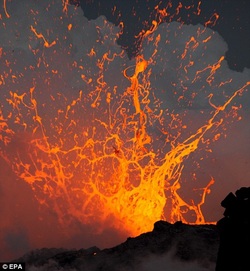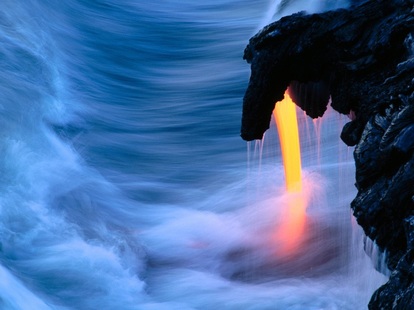Title.

Lava is made up of crystals, volcanic glass, and bubbles (volcanic gases). As magma gets closer to the surface and cools it begins to crystallize minerals like olivine and form bubbles of volcanic gases. When lava erupts it is made up of a slush of crystals, liquid, and bubbles. The liquid freezes to form volcanic glass.Chemically lava is made of the elements silicon, oxygen, aluminum, iron, magnesium, calcium, sodium, potassium, phosphorus, and titanium (plus other elements in very small concentrations.)
Lava is molten rock that spews from an erupting volcano. It is extremely hot, reaching temperatures as high as 1,300 to 2,000 degrees Fahrenheit (704 to 1093 degrees Celsius). In a volcanic eruption, lava is in liquid form. When it solidifies, it forms igneous rock. However, it can take quite a long time to cool, traveling great distances before becomes solid.Molten rock is not always called lava. Before a volcano erupts and molten rock is still underground, it is called magma. Besides being a little cooler, molten rock is not dramatically different once it's above ground. The distinction between magma and lava is basically made to make geological occurrences easier to understand and explain. Magma is the molten material beneath Earth's crust. This material consists of rock, gases, and mineral crystals. The temperature of the magma can be as high as 5000 degrees Fahrenheit. The pressure is also very high since the magma supports the weight of Earth's crust.
Lava is the molten rock that comes out of a volcano or from a fissure in Earth's surface. A fissure is a crack. The molten rock comes from the underground magma. Lava is really magma that has broken through Earth's surface. Lava is magma that has reached the surface. Magma can be formed from the subduction and melting of cold, dense, wet oceanic crust at some convergent plate margins. The moisture in the rock assists in the melting of the crust and the rock surrounding it. Magma is also formed at hot spots in the mantle where hot material undergoes decompression melting as it rises. Decompression melting also occurs at the mid-ocean ridges where new oceanic crust is formed from rising mantle rock.
Lava is molten rock that spews from an erupting volcano. It is extremely hot, reaching temperatures as high as 1,300 to 2,000 degrees Fahrenheit (704 to 1093 degrees Celsius). In a volcanic eruption, lava is in liquid form. When it solidifies, it forms igneous rock. However, it can take quite a long time to cool, traveling great distances before becomes solid.Molten rock is not always called lava. Before a volcano erupts and molten rock is still underground, it is called magma. Besides being a little cooler, molten rock is not dramatically different once it's above ground. The distinction between magma and lava is basically made to make geological occurrences easier to understand and explain. Magma is the molten material beneath Earth's crust. This material consists of rock, gases, and mineral crystals. The temperature of the magma can be as high as 5000 degrees Fahrenheit. The pressure is also very high since the magma supports the weight of Earth's crust.
Lava is the molten rock that comes out of a volcano or from a fissure in Earth's surface. A fissure is a crack. The molten rock comes from the underground magma. Lava is really magma that has broken through Earth's surface. Lava is magma that has reached the surface. Magma can be formed from the subduction and melting of cold, dense, wet oceanic crust at some convergent plate margins. The moisture in the rock assists in the melting of the crust and the rock surrounding it. Magma is also formed at hot spots in the mantle where hot material undergoes decompression melting as it rises. Decompression melting also occurs at the mid-ocean ridges where new oceanic crust is formed from rising mantle rock.
This is a picture of Lava flowing from a rock outlet into what seems to be an abundant stream of water, and cooling after it comes into contact with it.

